A golden rule applies to each one of us whether we are politicians, business tycoons or on the frontline of community service.
You must stand for something if you want to succeed. This applies as much to not for profit organisations as it does to individuals.
Before you step out to communicate your value you must have a firm idea of who you are, what you do and why you are important to your cause, your clients and your community.
Having a strong sense of identity is critical. It will guide how you work, what you say, who you engage and how and when you communicate. In marketing this sense of identity is called branding and it influences how you deliver services as well as every aspect of your outreach.
In 2001 I worked for a national organization responsible for promoting community harmony among Australians from different cultural backgrounds. The Federal Government had hand-picked high powered and accomplished professionals as Council members. The organisation had dedicated and professional staff. It had money and everyone expected big things.
Within six or so years it had ceased to exist. There were many reasons for its failure but a key one was it never defined its real purpose. It never found a sense of brand which meant it lacked conviction when it entered the public domain. A sad and visible result was a pattern of patchy and inconclusive communications. At the time a friend seeing this wasted potential and lost opportunities summed it up concisely: if they want attention they must stand for something.
We are all aware of the big brands: McDonalds, QANTAS, Chanel, Bank of America, Lloyds of London and the like. They behave in a consistent, certain way and when they speak they do so with clarity. Small organizations need to have a similar sense of purpose or brand. In fact it is even more important for them. They lack the resilience and strength of larger organizations and unless they are strongly focused they are easily elbowed aside and overlooked.
Sometime ago I worked with a prominent community organization that provided in-home services for older people and disabled individuals. The 35 person staff decided that to continue to succeed over the next 12 months collectively they had to come to:
- Show a consistent purpose.
- Deliver benefits clients, funding bodies, the media etc can readily see.
- Deliver those benefits to a high standard day in, day out throughout the year.
- Regularly reinvent the organization as community expectations changed.
- Communicate constantly to staff, clients and the key groups that shaped their environment.
These five points provide a pretty clear roadmap of what an organisation – or brand - must do to move from being good to becoming great.
But finally a word of caution. Do not confuse branding with logos, colours and symbols. The best graphic designs in the world cannot replace a sense of corporate purpose, clarity or commitment. These essentials must come first. The fancy blueprints for business cards, websites, office signs and the like can usually wait so beware the marketer who claims they are the mandatory first step.
 Of the ten or so marketing and PR books I have reviewed in the last 12 months the stand-out is Repositioning: marketing in an era of competition, change and crisis by Jack Trout and Steve Rivkin.
Of the ten or so marketing and PR books I have reviewed in the last 12 months the stand-out is Repositioning: marketing in an era of competition, change and crisis by Jack Trout and Steve Rivkin.

